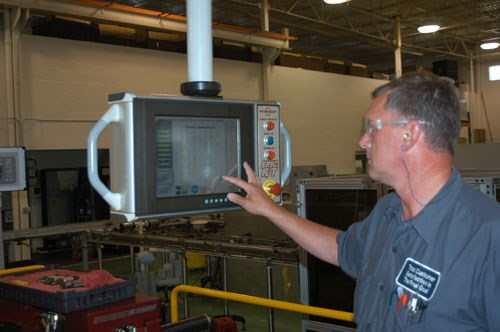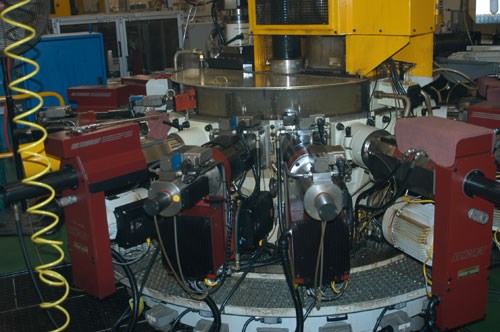Specialty Company Knows Its Collets
For almost 3 years Mr. Bouchard struggled with a machine application designed to produce life-critical airbag parts for Arrow Machine’s primary client in the automotive industry. With the help of RH Collets, a manufacturer of specialty workholding and related components for Hydromats and other machinery, Mr. Bouchard is solving the problem—not with one new part but with a series of solutions.
Everyone knows that a machine that’s not working properly means less productivity and less profit. When a machine breaks down it’s easy to assume the problem with one of the machine’s parts, and that the problem can be fixed by replacing or repairing that part. But as Paul Bouchard, Hydromat department manager at Arrow Machine Company (Mentor, Ohio) discovered, there are sometimes other solutions.
For almost 3 years Mr. Bouchard struggled with a machine application designed to produce life-critical airbag parts for Arrow Machine’s primary client in the automotive industry. The company’s part was spinning in the collet and breaking ejector heads. Arrow Machine, a manufacturer of screw machine products, assemblies and job shop services, needed to fix the problem before it experienced any more downtime on its 16-station Hydromat machines.
Although Hydromat has worked closely with the company to develop and build the right machine for Arrow’s use, Arrow couldn’t figure out where the problem was coming from. "Because we were constantly replacing the collets, it was taking longer to make the same number of parts, and our costs were growing," Mr. Bouchard says.
With the help of RH Collets, a manufacturer of specialty workholding and related components for Hydromats and other machinery, Mr. Bouchard is solving the problem—not with one new part but with a series of solutions.
"We worked closely with Charles Ruecker at RH Collets, and he helped us determine how to increase the holding power of the collet," explained Mr. Bouchard. "After replacing the collet, we decreased the cycle time and increased feed rates, and that means we have increased production." What this means to Arrow Machine is an increase in efficiency and ultimately an increase in profits.
RH Collets is in a unique position in the industry; the company has the knowledge and time to closely examine operational problems that can be overlooked while Hydromat operators are busy and machines are in operation.
By exploring different options to increase the holding power of the collet, Mr. Ruecker determined that the problem in the Hydromat was more than just a spinning collet damaging the ejector head. "Until now, the conventional approach to this type of problem was to look at methods to connect the ejector head to the ejector rod in a way to keep it from spinning," Mr. Ruecker explains. "But we determined that to fix the problem, a completely new collet needed to be designed."
RH Collets machines each collet from a solid blank and can design any type of collet they need for each individual situation. Mr. Ruecker took a new approach to a common problem and designed a feature directly into the collet that produced a high level of built-in rigidity. This new collet stopped the spinning.
By examining how the collet interacted with other parts of the machine, Mr. Ruecker also determined that the way the ejector head is locked in position also needed to be changed. "By making that modification, we added more resistance to keep the part from moving around even more," he explains.
The newly designed collet was extended to contact as much of the part as possible. This—increasing the clamping surface area—was not possible with standard collet blanks. Mr. Ruecker also built a hex feature into the bottom of the new collet bore that matches the one on the ejector head. This eliminates ejector head spinning and in turn, stops the collet from moving.
"This head will never spin because it has a high level of rigidity built right into it," he says. "That will help keep the part from spinning."
The results of the new collet have significantly impacted the shop. "With the new collet, we are able to increase our feed rates on the units that have the longest cycle time. This makes our cycle time faster, and we can produce more parts," Mr. Ruecker
continues.
Arrow Machine manufactures 3 million airbag parts per year. When all the new collets are fully functioning in all stations, the production time is expected to decrease. In the meantime the company has a solution that has significantly cut its cost of operation.
In order for this collet change to work, RH Collets also found that Arrow Machine needed a new design for the pickoff grippers that load and unload the part. RH Collets supplied the engineering designs for Arrow Machine to modify the existing pickoff grippers in-house to ensure that the collet modifications would work with existing equipment features.
"We went beyond the collet and went into engineering other components of the Arrow machine to make sure everything worked together properly," Mr. Ruecker says. "Arrow is willing to work with us to support what to do, and that produces a better solution for the company."
"RH works very closely with our process," Mr. Bouchard adds. "If there is an issue, we discuss what I am trying to achieve, whether it’s achievable and exactly what the next steps are to get there. And everything is always completely confidential—that’s reassuring."
As Arrow Machine expands its operations, it is important to have a reliable relationship with a vendor like RH Collets, Mr. Bouchard explains. Arrow Machine currently has a staff of 120 people and is fully operational 6-days per week with machines running 24 hours a day. It has increased its sales by 50 percent each year throughout the last 5 years and expects to do the same this year.
"The three things that our customers rate us on are price, quality and delivery, and RH Collets helps us give our clients top service and value," says Mr. Bouchard. "With its help, we are able to keep up with new equipment and ensure that it is running smoothly."
Related Content
CNC Turning Tips for HRSA Materials
Rough-turning, heat-resistant superalloys can be challenging. However, new carbide insert technology provides the capability to perform high-speed, high-feed roughing in a single pass.
Read MoreThe Value of Swiss-Types Milling Rectangular Medical Parts
High-speed spindle technology was key to effective milling of small cardiac monitoring components complete on a CNC sliding-headstock machine platform instead of running them across two mills.
Read MoreTool Path Improves Chip Management for Swiss-Type Lathes
This simple change to a Swiss-type turning machine’s tool path can dramatically improve its ability to manage chips.
Read MoreWhat Is Trochoidal Turning? How Might Shops Benefit From It?
While trochoidal milling might be a more well-known toolpath strategy, trochoidal turning can offer similar benefits such as high material removal rates especially for rough-turning operations.
Read MoreRead Next
Do You Have Single Points of Failure?
Plans need to be in place before a catastrophic event occurs.
Read MoreA Tooling Workshop Worth a Visit
Marubeni Citizen-Cincom’s tooling and accessory workshop offers a chance to learn more about ancillary devices that can boost machining efficiency and capability.
Read More5 Aspects of PMTS I Appreciate
The three-day edition of the 2025 Precision Machining Technology Show kicks off at the start of April. I’ll be there, and here are some reasons why.
Read More












.jpg;maxWidth=300;quality=90)












